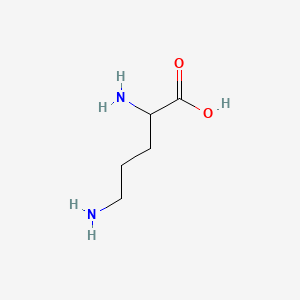| MeSH term | MeSH ID | Detail |
|---|---|---|
| Uremia | D014511 | 33 associated lipids |
| Stomach Ulcer | D013276 | 75 associated lipids |
| Kidney Failure, Chronic | D007676 | 51 associated lipids |
| Diabetes Mellitus | D003920 | 90 associated lipids |
| Adenocarcinoma | D000230 | 166 associated lipids |
| Lupus Erythematosus, Systemic | D008180 | 43 associated lipids |
| Lung Neoplasms | D008175 | 171 associated lipids |
| Wounds and Injuries | D014947 | 20 associated lipids |
| Burns | D002056 | 34 associated lipids |
| Adenoma, Islet Cell | D007516 | 7 associated lipids |
2,5-diaminopentanoic acid
2,5-diaminopentanoic acid is a lipid of Fatty Acyls (FA) class. The involved functions are known as Vasodilation, Intestinal Absorption and Pinocytosis. 2,5-diaminopentanoic acid often locates in Mitochondria, Microfilaments, NADH dehydrogenase complex and respiratory chain complex III location sensu Eukarya. The associated genes with 2,5-diaminopentanoic acid are GAPDH gene and iberiotoxin.
Cross Reference
Introduction
To understand associated biological information of 2,5-diaminopentanoic acid, we collected biological information of abnormalities, associated pathways, cellular/molecular locations, biological functions, related genes/proteins, lipids and common seen animal/experimental models with organized paragraphs from literatures.
What diseases are associated with 2,5-diaminopentanoic acid?
There are no associated biomedical information in the current reference collection.
Possible diseases from mapped MeSH terms on references
We collected disease MeSH terms mapped to the references associated with 2,5-diaminopentanoic acid
PubChem Associated disorders and diseases
What pathways are associated with 2,5-diaminopentanoic acid
There are no associated biomedical information in the current reference collection.
PubChem Biomolecular Interactions and Pathways
Link to PubChem Biomolecular Interactions and PathwaysWhat cellular locations are associated with 2,5-diaminopentanoic acid?
Visualization in cellular structure
Associated locations are in red color. Not associated locations are in black.
Related references are published most in these journals:
| Location | Cross reference | Weighted score | Related literatures |
|---|
What functions are associated with 2,5-diaminopentanoic acid?
Related references are published most in these journals:
| Function | Cross reference | Weighted score | Related literatures |
|---|
What lipids are associated with 2,5-diaminopentanoic acid?
There are no associated biomedical information in the current reference collection.
What genes are associated with 2,5-diaminopentanoic acid?
Related references are published most in these journals:
| Gene | Cross reference | Weighted score | Related literatures |
|---|
What common seen animal models are associated with 2,5-diaminopentanoic acid?
There are no associated biomedical information in the current reference collection.
NCBI Entrez Crosslinks
All references with 2,5-diaminopentanoic acid
Download all related citations| Authors | Title | Published | Journal | PubMed Link |
|---|---|---|---|---|
| Witalison EE et al. | Protein Arginine Deiminases and Associated Citrullination: Physiological Functions and Diseases Associated with Dysregulation. | 2015 | Curr Drug Targets | pmid:25642720 |
| Li M et al. | [Novel immobilization of arginase I via cellulose-binding domain and its application in producing of L-ornitine]. | 2014 Jan-Feb | Prikl. Biokhim. Mikrobiol. | pmid:25272752 |
| González-Villanueva L et al. | The PhtL protein of Pseudomonas syringae pv. phaseolicola NPS3121 affects the expression of both phaseolotoxin cluster (Pht) and Non-Pht encoded genes. | 2014 Feb-Mar | Microbiol. Res. | pmid:23806843 |
| Tsiapa I et al. | Evaluation of ανβ3-mediated tumor expression with a 99mTc-labeled ornithine-modified RGD derivative during glioblastoma growth in vivo. | 2014 | Cancer Biother. Radiopharm. | pmid:25405951 |
| Stevens LA et al. | Nonenzymatic conversion of ADP-ribosylated arginines to ornithine alters the biological activities of human neutrophil peptide-1. | 2014 | J. Immunol. | pmid:25392530 |
| Sánchez Mainar M et al. | Coagulase-negative Staphylococci favor conversion of arginine into ornithine despite a widespread genetic potential for nitric oxide synthase activity. | 2014 | Appl. Environ. Microbiol. | pmid:25281381 |
| Saitoh W et al. | Metabolomic analysis of arginine metabolism in acute hepatic injury in rats. | 2014 | J Toxicol Sci | pmid:24418708 |
| Pandey RK et al. | Chemical synthesis of staphyloferrin A and its application for Staphylococcus aureus detection. | 2014 | Org. Biomol. Chem. | pmid:24500249 |
| Li Y et al. | Citrullinated histone H3: a novel target for the treatment of sepsis. | 2014 | Surgery | pmid:24957671 |
| Fukuyama S et al. | Characterization of a thermostable 2,4-diaminopentanoate dehydrogenase from Fervidobacterium nodosum Rt17-B1. | 2014 | J. Biosci. Bioeng. | pmid:24326351 |
